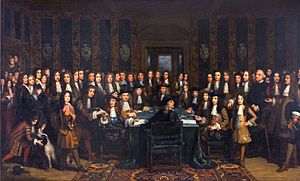Treaties of Nijmegen facts for kids
| Traités de Paix de Nimègue (French) | |
|---|---|

Dutch and French diplomats signing the peace treaty
|
|
| Context | Franco-Dutch War: Franco-Dutch War end; France control Franche-Comté, select Flanders cities, and Hainaut. |
| Signed | 1678–79 |
| Location | Nijmegen, Dutch Republic |
| Parties |
|
The Treaties of Peace of Nijmegen were a group of important agreements. They were signed in the Dutch city of Nijmegen between August 1678 and October 1679. These treaties officially ended several wars that were connected to each other.
The main countries involved were France, the Dutch Republic, Spain, Brandenburg, Sweden, Denmark-Norway, the Prince-Bishopric of Münster, and the Holy Roman Empire. The most important treaty was the first one. It brought peace between France and the Dutch Republic. This treaty also set the northern border of France very close to where it is today.
Contents
Why Were the Treaties Needed?
The main reason for these treaties was the Franco-Dutch War. This war lasted from 1672 to 1678. Many other conflicts, like the Third Anglo-Dutch War and the Scanian War, were part of this larger conflict.
At first, England fought alongside France. But they left the war in 1674 after signing the Treaty of Westminster. The Electorate of Cologne also left the war in 1674. The Prince-Bishopric of Münster changed sides that year. They joined the group fighting against France. Denmark-Norway also joined the anti-French side in 1675. They mostly fought against Sweden.
Who Fought in the Wars?
At the end of the Franco-Dutch and Scanian Wars, these were the main groups fighting:
- Countries against France
 Dutch Republic
Dutch Republic Spanish Empire (including Spanish Netherlands)
Spanish Empire (including Spanish Netherlands) Denmark-Norway
Denmark-Norway Holy Roman Empire:
Holy Roman Empire:
 Brandenburg-Prussia
Brandenburg-Prussia Prince-Bishopric of Münster
Prince-Bishopric of Münster Principality of Lüneburg (Celle)
Principality of Lüneburg (Celle) Duchy of Lorraine
Duchy of Lorraine
- France and its friends
The Peace Treaties Signed
Discussions about peace started as early as 1676. However, no agreements were made until 1678. Most of the treaties were signed in Nijmegen. This is why all the documents together are called the 'Treaties of Nijmegen'.
Some countries signed peace deals in other places. For example, the Treaty of Celle was signed between Sweden and Lüneburg (Celle). The Treaty of Saint-Germain brought peace between France, Sweden, and Brandenburg. The Treaty of Fontainebleau was where France arranged peace between Sweden and Denmark-Norway.
| Treaties of Nijmegen and related treaties | |||||
|---|---|---|---|---|---|
| Date | Treaty | Anti-French side | French side | Text | Refs |
| 10 August 1678 | Treaty of Nijmegen | Dutch Republic | France | Dutch | |
| 10 August 1678 | (separate trade treaty) | Dutch Republic | France | ||
| 17 September 1678 | Treaty of Nijmegen | Spain | France | French | |
| 5 February 1679 | Treaty of Nijmegen | Holy Roman Empire | France and Sweden | Latin/Swedish, German | |
| 5 February 1679 | Treaty of Celle | Lüneburg (Celle) | Sweden (and France) | ||
| 19 March 1679 | Treaty of Nijmegen | Münster | Sweden | ||
| 29 June 1679 | Treaty of Saint-Germain | Brandenburg-Prussia | France (and Sweden) | ||
| 2 September 1679 | Treaty of Fontainebleau | Denmark-Norway | Sweden (and France) | ||
| 26 September 1679 | Peace of Lund | Denmark-Norway | Sweden (and France) | ||
| 12 October 1679 | Treaty of Nijmegen | Dutch Republic | Sweden | ||
What Were the Outcomes of the Treaties?
The Franco–Dutch War ended with a treaty that gave France control over the Franche-Comté region. France also gained more land in the Spanish Netherlands. These new lands were added to those France had already taken in earlier treaties. These earlier agreements were the 1659 Treaty of the Pyrenees and the 1668 Treaty of Aix-la-Chapelle.
The new lands for France included the town of Saint-Omer. It also included parts of the old Imperial County of Artois. France gained towns like Cassel, Aire, and Ypres in southwestern Flanders. The Bishopric of Cambrai also became French. Finally, the towns of Valenciennes and Maubeuge in the southern County of Hainaut were given to France.
In return, the French King Louis XIV gave back the town of Maastricht. He also returned the Principality of Orange to the Dutch leader, William III. French soldiers also left several areas they had taken in northern Flanders and Hainaut.
Emperor Leopold I kept the fortress of Philippsburg. However, he had to accept that France would control the towns of Freiburg (until 1697) and Kehl (until 1698). These towns are on the right bank of the Rhine river.
Even with these treaties, the peace did not last forever.
Cultural Impact
A famous composer named Marc-Antoine Charpentier wrote a special piece of music. It was a Te Deum created for this occasion. The beginning part of this Te Deum is now very well-known. It is used as the theme music for the Eurovision Song Contest.
See also
- Louis XIV Victory Monument
 In Spanish: Tratados de Nimega para niños
In Spanish: Tratados de Nimega para niños

